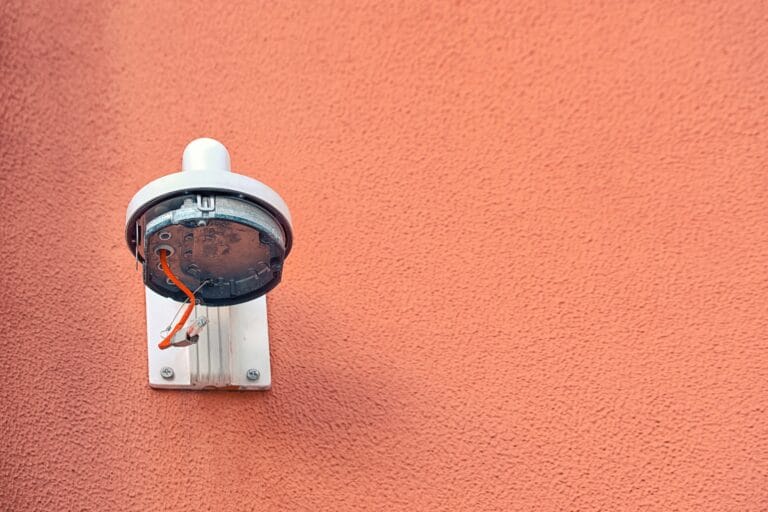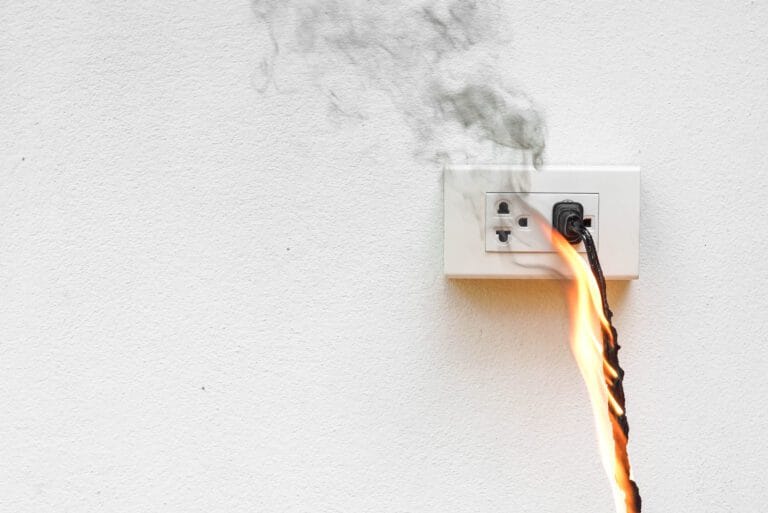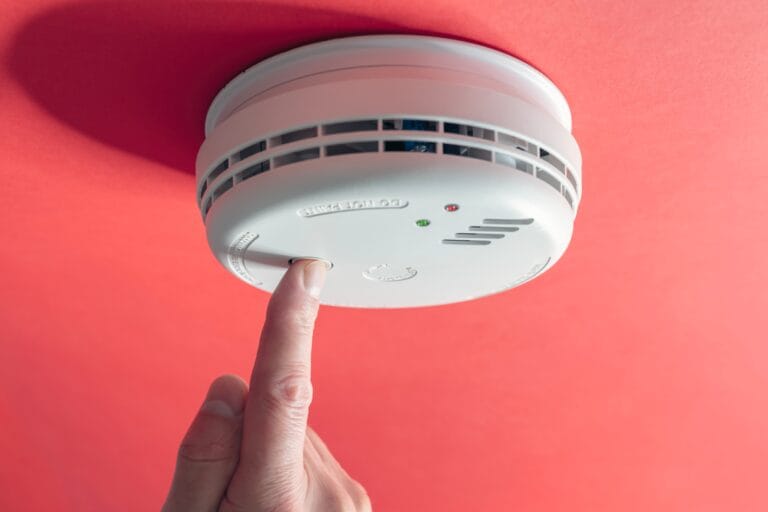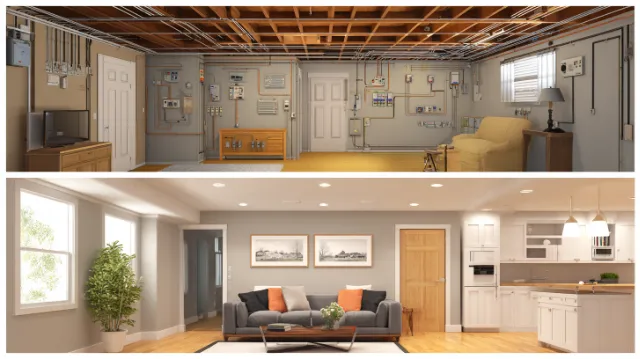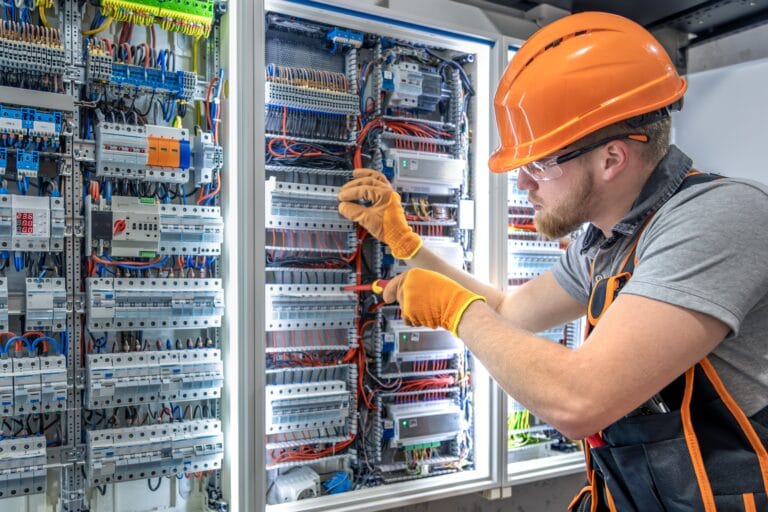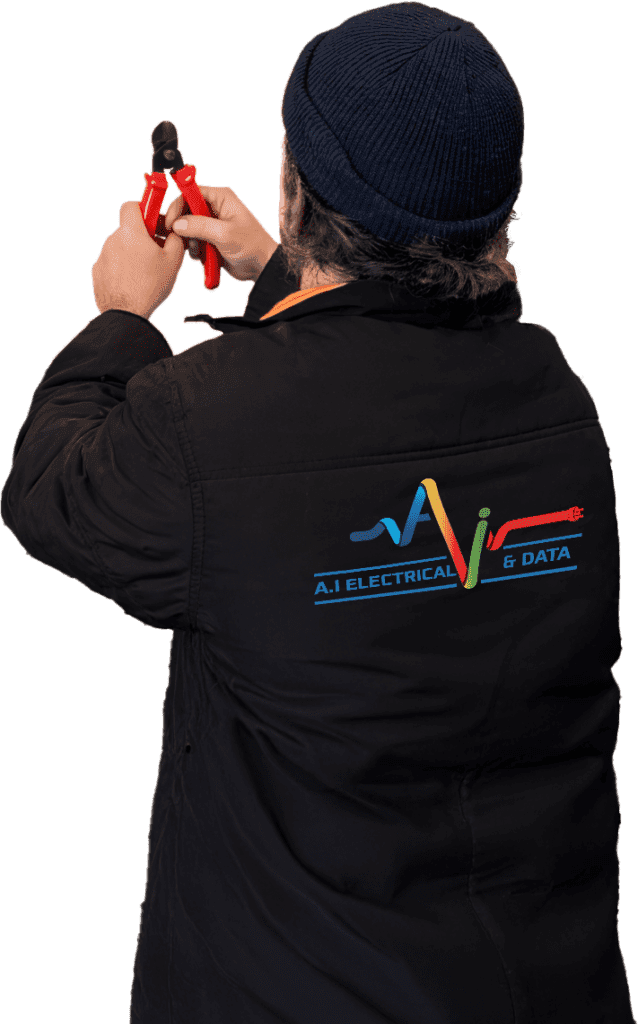Understanding Switchboard Upgrades
A switchboard upgrade involves replacing your home’s electrical distribution board with a modern system designed to meet current safety standards and power demands. The process requires a licensed electrician to disconnect the existing board, install new circuit breakers, integrate safety switches, and ensure all connections comply with Australian electrical regulations. The upgrade typically includes installing Residual Current Devices (RCDs), circuit breakers, surge protection, and a new meter board connection.
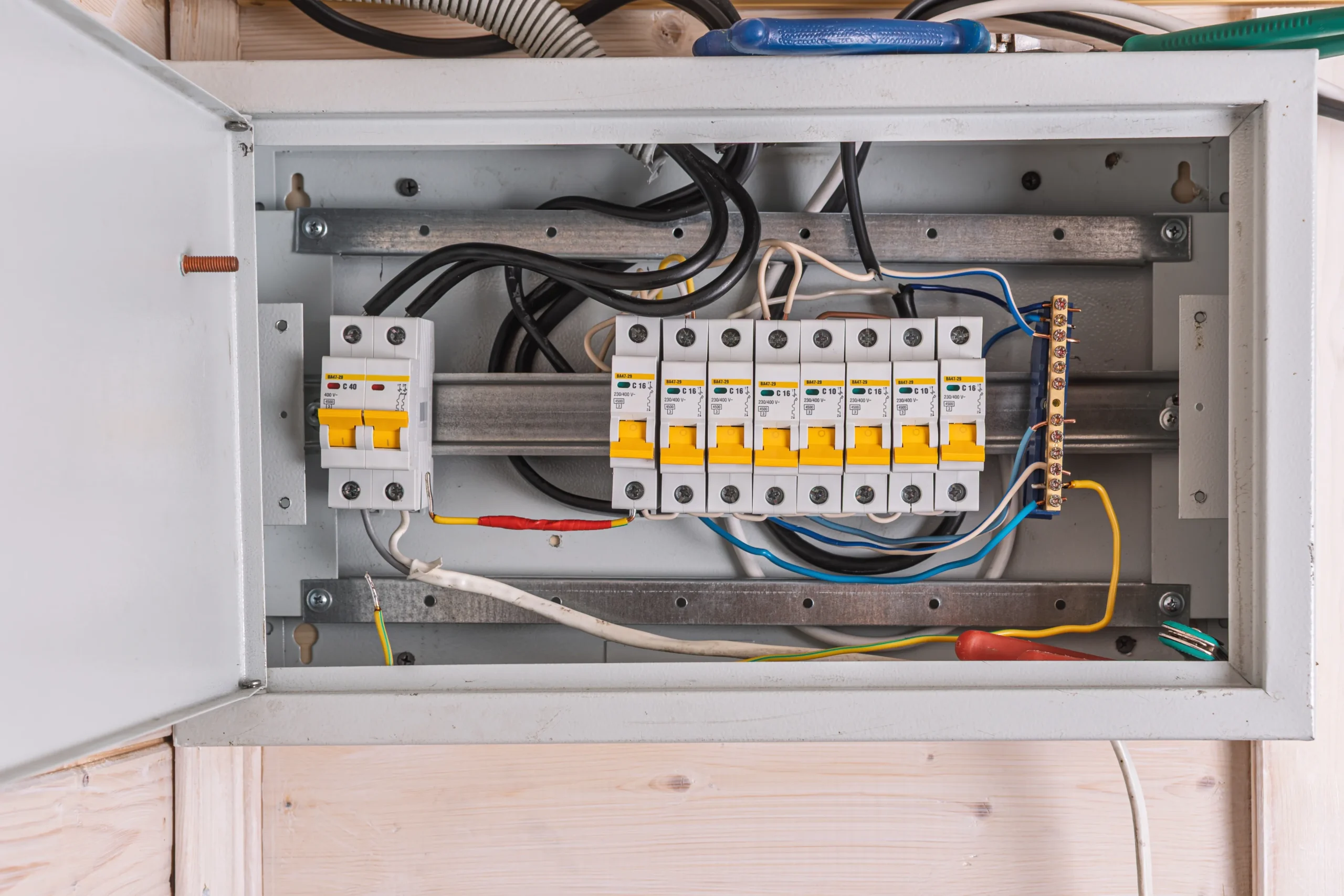
If you’re considering this upgrade, don’t hesitate to contact us for professional assistance.
Old vs. Modern Switchboards: Critical Differences
Older switchboards—often featuring ceramic fuses or rewirable fuses—lack the protective mechanisms that modern homes require. These outdated systems present serious limitations:
Old Switchboards:
Modern Switchboards:
Why Switchboard Upgrades Are Essential in 2025
Switchboard upgrades will be crucial in 2025. Old switchboards pose major safety risks to Australian homes every day. Ceramic fuses and traditional circuit breakers don’t respond quickly enough to stop electrical fires. When circuits overload, these outdated systems can take seconds—or fail completely—to cut off power, causing wires to overheat and ignite nearby materials.
Another serious threat is electrical shocks. Older switchboards lack ground fault protection, meaning a faulty appliance or damaged wire can deliver a deadly shock before the system reacts. Children touching exposed outlets, homeowners using wet appliances, or tradespeople working on home renovations are all at unnecessary risk of electrocution.
How Modern Safety Features Provide Better Protection
Residual Current Devices (RCDs) have revolutionized electrical safety in homes. These devices can detect imbalances in electrical current within milliseconds and shut off power in as little as 0.03 seconds if they sense electricity flowing through an unintended path, such as a person’s body. Australian electrical standards now require RCD protection for all power points and lighting circuits—a requirement that many older homes cannot meet without upgrading their entire switchboard.
Newer switchboards also come with:
Preparing for Future Energy Needs
Australian households are quickly embracing new technologies that require strong electrical systems. Solar panel installations need dedicated circuits and proper earthing systems. Electric vehicle chargers use a lot of power—usually 7.4kW or more—so they need upgraded capacity and special protection circuits. Battery storage systems require advanced monitoring and safety disconnects.
Houses with old switchboards cannot safely or legally support these technologies. Upgrading now will save you from expensive retrofitting later on and make sure your electrical system can handle the shift towards renewable energy that is transforming Australian homes.
Factors Influencing Switchboard Upgrade Costs in Melbourne
The switchboard upgrade price varies significantly across Melbourne, with multiple elements determining your final investment. Understanding these factors helps you budget accurately and avoid unexpected expenses.
Installation Complexity and Technical Requirements
The scope of work directly impacts your switchboard upgrade cost. Simple replacements differ dramatically from complex installations:
Single-phase upgrades suit most residential properties with standard electrical demands. These straightforward installations involve replacing an existing board with a modern equivalent, typically requiring 3-6 hours of work.
Three-phase upgrades cater to properties with substantial power requirements—homes with ducted air conditioning, large workshops, or multiple high-draw appliances. These installations demand:
- Additional circuit breakers and safety switches
- More extensive wiring modifications
- Potential meter box upgrades
- Coordination with your electricity distributor
Properties requiring asbestos removal from old switchboards, extensive rewiring, or structural modifications to accommodate larger boards face significantly higher costs. The age and condition of your existing electrical infrastructure also influences pricing—older homes often need additional remedial work to meet current safety standards.
Cost Ranges for Switchboard Upgrades by Location (2025)
The cost to upgrade switchboard infrastructure varies significantly across Melbourne regions, reflecting differences in labour rates, demand, and local market conditions. Understanding these cost ranges for switchboard upgrades by location helps you budget accurately for your electrical safety investment.
Switchboard Upgrade Costs in Melbourne (2025)
|
House Type |
Upgrade Type |
Typical Cost Range (AUD) |
Notes |
|---|---|---|---|
|
Small Unit / Apartment |
Single-phase upgrade |
$1,800 – $2,400 |
Basic upgrade, suitable for standard appliances and lighting. |
|
Small–Medium Home |
Single-phase upgrade |
$2,200 – $3,000 |
Includes RCDs, surge protection, and extra circuits if required. |
|
Large Family Home |
Three-phase upgrade |
$2,800 – $4,000 |
Supports ducted aircon, multiple high-power appliances. |
|
Renovated / Modern Home |
Premium three-phase |
$3,500 – $4,500 |
Advanced protection (arc fault, surge), future-ready for EV/solar. |
|
Heritage / Older Property |
Upgrade with asbestos |
$3,200 – $4,500+ |
Extra cost due to asbestos removal, rewiring, and compliance work. |
Understanding Different Types of Switchboards and Their Cost Implications
The types of switchboards and their cost implications vary significantly based on construction materials, safety features, and capacity requirements. Melbourne homes typically use one of three main switchboard configurations, each designed for specific electrical demands and safety standards.
1. Air-Insulated Switchboards
Air-Insulated Switchboards represent the most common choice for residential properties. These units use air as the primary insulation medium between conductive parts, making them cost-effective and straightforward to maintain. Standard air-insulated switchboards range from $1,500 to $3,000 for basic installations. They work well for homes with standard electrical requirements and provide adequate protection when fitted with modern safety devices.
2. Cast Resin Switchboards
Cast Resin Switchboards offer enhanced durability and safety through their solid insulation construction. The resin encapsulation protects internal components from moisture, dust, and environmental factors. These premium units typically cost between $3,500 and $6,000, making them ideal for homes in coastal areas or locations with harsh weather conditions. The higher price reflects their superior protection against corrosion and reduced maintenance needs over time.
3. Modular Switchboards
Modular Switchboards provide maximum flexibility for homes with evolving electrical needs. These systems allow easy expansion and reconfiguration without replacing the entire unit. Prices start at $2,200 and can reach $5,500 depending on the number of circuits and future expansion capacity. Homeowners planning to add solar panels, electric vehicle chargers, or home automation systems benefit from this adaptable solution.
Signs That Your Home Requires an Immediate Switchboard Upgrade
Your electrical system communicates warning signs when it can no longer handle your household’s demands safely. Recognizing these indicators helps prevent dangerous situations and costly damage.
1. Frequent Circuit Breaker Trips
When your circuit breakers trip repeatedly, your switchboard struggles to manage the electrical load. This constant interruption signals an urgent need for assessment by qualified professionals.
2. Flickering or Dimming Lights
Lights that flicker when you turn on appliances indicate your switchboard lacks the capacity to distribute power efficiently across your home’s circuits.
3. Burning Smell or Scorch Marks
Any burning odor near your switchboard or visible scorch marks on the unit demands immediate attention. These signs point to dangerous overheating that could spark a fire.
4. Ceramic Fuses Instead of Circuit Breakers
Homes still using ceramic fuses operate with outdated technology that lacks modern safety protections. These systems pose serious risks and require immediate replacement.
5. Absence of Safety Switches (RCDs)
If your switchboard doesn’t include Residual Current Devices, your family remains vulnerable to electrical shocks. Current regulations mandate these life-saving devices in all residential properties.
6. Renovation or Major Appliance Addition
Installing air conditioning, electric vehicle chargers, or solar panels strains older switchboards beyond their design capacity. Your existing system needs upgrading to accommodate these power-hungry additions safely.
7. Age Exceeding 25 Years
Switchboards older than 25 years lack the safety features and capacity modern households demand. The cost of upgrading now prevents expensive emergency repairs later.
Legal Compliance Considerations When Upgrading Your Switchboard in Melbourne
Melbourne electrical work operates under strict regulations designed to protect homeowners and properties. Only licensed electricians holding the appropriate qualifications can legally perform switchboard upgrades. Attempting DIY electrical work or hiring unlicensed individuals puts your home at serious risk and invalidates insurance coverage.
Your electrician must obtain the necessary permits before commencing work. These permits ensure the upgrade meets Australian Standards (AS/NZS 3000:2018) and local building codes. The process typically involves:
Certain situations legally mandate a switchboard upgrade. You cannot avoid this requirement when:
Electrical distributors may refuse to reconnect power if work doesn’t comply with regulations. Your licensed electrician handles all compliance documentation, ensuring your upgrade meets every legal requirement. This professional oversight protects your investment and guarantees your family’s safety.
Tips For Getting The Best Value From Your 2025 Switch Board Upgrade Project
Securing the best value for your switchboard upgrade requires strategic planning and informed decision-making. Start by verifying that any electrician you consider holds a current electrical contractor’s license. Check their credentials through your state’s regulatory body and review customer testimonials to gauge their reliability.
Request detailed, itemized quotes from at least three licensed electricians in your area. A transparent quote should clearly outline:
When comparing quotes, the lowest price doesn’t always represent the best value. Examine what each quote includes—some electricians may offer premium safety switches or extended warranties that justify a higher initial cost.
Ask specific questions about the switchboard model being installed, the brand of circuit breakers, and whether RCDs are included for all circuits. Request clarification on any vague line items to prevent surprise charges.
Timing can impact your costs. Some electricians offer reduced rates during quieter periods or may bundle services if you’re completing other electrical work simultaneously.
Confirm the electrician provides a written guarantee on their work and maintains adequate insurance coverage. This protects you if issues arise after installation, ensuring your investment delivers long-term safety and reliability.
FAQs (Frequently Asked Questions)
What does a switchboard upgrade involve and why is it important?
A switchboard upgrade entails replacing or enhancing your home’s electrical switchboard to improve safety and capacity. It involves installing modern components such as circuit breakers and Residual Current Devices (RCDs) that protect against fire hazards and electrical shocks. Upgrading is crucial due to increased power demands from modern appliances and emerging technologies like solar panels and electric vehicle chargers.
Why are switchboard upgrades particularly necessary in 2025?
In 2025, outdated switchboards pose heightened safety risks including fire hazards and lack of adequate protection against electrical shocks. Upgrading ensures compliance with current safety standards, incorporates advanced features like RCDs, and future-proofs homes to handle rising electricity consumption from new technologies such as solar energy systems and electric vehicle charging stations.
How much does a switchboard upgrade typically cost in Melbourne in 2025?
Switchboard upgrade costs in Melbourne vary depending on factors like location, complexity of installation, and type of switchboard. For example, prices differ between major cities such as Melbourne, Sydney, Brisbane, Perth, Adelaide, and regional areas. Generally, single-phase upgrades are less expensive than three-phase ones. It’s advisable to obtain multiple quotes from licensed electricians to get accurate pricing tailored to your specific needs.
What types of switchboards are available and how do they affect the cost?
There are various types of switchboards including air-insulated and cast resin models. Each type has distinct price ranges influenced by materials used, durability, and installation requirements. Choosing the right type depends on your household’s electrical load and safety needs. Understanding these options helps in budgeting effectively for your switchboard upgrade project.
What signs indicate that my home requires an immediate switchboard upgrade?
Indicators include frequent circuit breaker trips, flickering lights, visible damage or corrosion on the switchboard, outdated fuse systems instead of circuit breakers, or receiving electrical defect notices. These signs suggest your existing switchboard may be unsafe or insufficient for your household’s current electrical demands and warrant prompt professional assessment.
Are there legal requirements for upgrading a switchboard in Melbourne?
Yes, upgrading a switchboard in Australia requires compliance with legal standards including hiring licensed electricians who hold appropriate certifications. Mandatory permits and inspections ensure work meets safety regulations. Certain situations such as adding new wiring or appliances legally require an upgrade to maintain electrical safety and code compliance.

